Research News
-
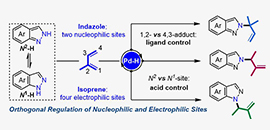 02 08, 2021Orthogonal Regulation Strategy Offers New Opportunities for Buildup of Molecular ComplexityResearchers developed an orthogonal regulation of nucleophilic and electrophilic sites in Pd-catalyzed regiodivergent couplings between indazoles and isoprene.
02 08, 2021Orthogonal Regulation Strategy Offers New Opportunities for Buildup of Molecular ComplexityResearchers developed an orthogonal regulation of nucleophilic and electrophilic sites in Pd-catalyzed regiodivergent couplings between indazoles and isoprene.
Dimethylallyl-related units play a significant role in enhancing lipophilicity of molecules and facilitating permeation across the cellular membrane.
Isoprene can serve as a precursor in the chemical synthesis of dimethylallyl-derived molecules. And indazoles are pharmacologically important scaffolds that found in numerous natural products and drugs.
Recently, a team led by Prof. CHEN Qing'an from the Dalian Institute of Chemical Physics (DICP) of the Chinese Academy of Sciences (CAS), in cooperation with Associate Professor JIANG Xuliang from Shenyang Pharmaceutical University, proposed a strategy that could realize orthogonal regulation of nucleophilic and electrophilic sites in Pd-catalyzed regiodivergent couplings between indazoles and isoprene.
Their findings were published in Angew. Chem. Int. Ed. on Jan. 18.
Pd-catalytic regiodivergent dimethylallylation of indazole with isoprene (Image by JIANG Wenshuang and JI Dingwei)
The researchers found that the 1,2-or 4,3-insertion pathway with respect to the electrophilic sites on isoprene could be controlled by the choice of ligands under Pd-hydride catalysis.
In terms of the nucleophilic sites on indazoles, the reaction occurred at either the N1-or N2-position of indazoles was governed by the acid co-catalysts.
This study not only contributes a practical tool for selective functionalization of isoprene, but also provides a guide to manipulate the regioselectivity for the N-functionalization of indazoles.
"This orthogonal regulation strategy of nucleophilic and electrophilic sites offers new opportunities for the buildup of molecular complexity," said Prof. CHEN.
This research was supported by the National Natural Science Foundation of China and Liaoning Revitalization Talents Program. (Text by JIANG Wenshuang and JI Dingwei) -
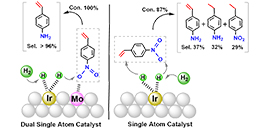 02 05, 2021Scientists Reveal Synergistic Effects in Dual Single-atom CatalystResearchers elucidated synergistic catalysis of dual single-atom structure in the selective hydrogenation 4-nitrostyrene (4-NS) to 4-vinylaniline (4-VA).
02 05, 2021Scientists Reveal Synergistic Effects in Dual Single-atom CatalystResearchers elucidated synergistic catalysis of dual single-atom structure in the selective hydrogenation 4-nitrostyrene (4-NS) to 4-vinylaniline (4-VA).
Single-atom catalysts (SACs) are applied in heterogeneous catalysis. Instead of one type of single atom, dual single-atom catalysts (DSACs) deliver superior catalytic performance than SACs due to cooperation between the dual metal-atoms.
Understanding synergistic effects at the atomic scale is critical for the design of highly effective heterogeneous catalysts in chemical transformation.
Recently, Prof. HUANG Jiahui's group and Prof. FU Qiang's group from the Dalian Institute of Chemical Physics (DICP) of the Chinese Academy of Sciences (CAS), in cooperation with Prof. SI Rui from Shanghai Institute of Applied Physics, CAS, revealed synergistic catalysis of dual single-atom structure in the selective hydrogenation 4-nitrostyrene (4-NS) to 4-vinylaniline (4-VA).
The study was published in ACS Catalysis on January 29.
Synergistic effects for enhanced catalysis in a dual single-atom catalyst (Image by FU Junhong)
The researchers synthesized DSAC Ir1Mo1/TiO2 as well as SACs Ir1/TiO2 and Mo1/TiO2. They found that DSAC Ir1Mo1/TiO2 displayed a superior catalytic performance for selective hydrogenation of 4-NS to 4-VA than SACs Ir1/TiO2 and Mo1/TiO2.
Computational results indicated that H2 activation occurred on Ir1 and 4-NS adsorption via the nitro group preferentially occurred on Mo1, with the synergistic effect of Ir1 and Mo1 leading to enhanced catalytic performance.
This work elucidates the atomic level advantages of DSAC in promoting reaction mechanisms for efficient heterogeneous bimetallic catalysis.
This study was supported by National Natural Science Foundation of China, the Strategic Priority Research Program of Chinese Academy of Sciences, National Key R&D Program of China, Projects of International Cooperation and Exchanges NSFC, and International Postdoctoral Exchange Fellowship Program. (Text by FU Junhong) -
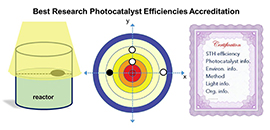 02 05, 2021Scientists Propose to Establish Testing Standards for Particulate Photocatalysts in Solar Fuel ProductionResearchers initiated the establishment of international efficiency accreditation and testing protocols for particulate photocatalysts toward solar fuel production.
02 05, 2021Scientists Propose to Establish Testing Standards for Particulate Photocatalysts in Solar Fuel ProductionResearchers initiated the establishment of international efficiency accreditation and testing protocols for particulate photocatalysts toward solar fuel production.
Utilization of renewable solar energy is crucial for addressing the global energy and environmental concerns and achieving sustainable development in our society. In this regard, photocatalytic water splitting has attracted significant interest as a cost-effective means to convert sustainable solar energy into valuable chemicals.
However, efficiency is sensitive to reaction conditions and experimental setup, it is difficult to compare the results obtained by different research groups or provide a reliable guide for large-scale implementation. Due to the lack of testing standards, it is difficult to compare the results obtained by different research groups or provide a reliable guide for large-scale implementation.
Recently, a research team led by Prof. LI Can and Prof. LI Rengui from the Dalian Institute of Chemical Physics (DICP) of the Chinese Academy of Sciences (CAS), in collaboration with Prof. Kazunari Domen from The University of Tokyo, Prof. Lianzhou Wang from The University of Queensland, Prof. Kazuhiro Sayama from the National Institution of Advanced Industrial Science and Technology, and Prof. Gang Liu from the Institute of Metal Research, CAS, initiated the establishment of international efficiency accreditation and testing protocols for particulate photocatalysts toward solar fuel production.
Efficiency accreditation and testing protocols for particulate photocatalysts toward solar fuel production (Image by LI Rengui)
Their perspective, published in Joule, was expected to serve as a useful guide for developing a well-recognized testing standard and for further promoting research advances in the field of photocatalytic solar energy conversion.
The researchers discussed the protocols for the reliable determination of the efficiency of the overall photocatalytic water splitting reaction based on particulate photocatalysts.
They also proposed to establish accreditation research laboratories for efficiency certification toward the launch of a figure of merit - a "Best research photocatalyst efficiencies" chart.
This initiative would provide an important platform for establishing standard testing protocols for photocatalytic water splitting and for improving the solar-to-hydrogen conversion efficiency in practical applications.
This work was supported by the National Natural Science Foundation of China. (Text by LI Rengui) -
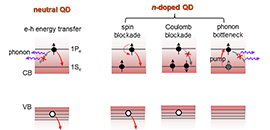 01 29, 2021Scientists Observe Very Slow Hot Electron Cooling in Electron-doped Quantum DotsScientists recently observed the hot electrons as long-lived as more than 300 picoseconds in n-doped colloidal quantum dots enabled by spin blockade and phonon bottleneck.
01 29, 2021Scientists Observe Very Slow Hot Electron Cooling in Electron-doped Quantum DotsScientists recently observed the hot electrons as long-lived as more than 300 picoseconds in n-doped colloidal quantum dots enabled by spin blockade and phonon bottleneck.
In conventional solar cells, the excessive energy of carriers above the band gap of a semiconductor is lost in the form of heat due to rapid cooling of hot carriers via emission of phonons. This is a major reason for Shockley–Queisser limit of solar cell efficiency.
Extraction the hot carrier to selective contacts has the potential to boost power conversion efficiency of solar cells to as high as 66%. The challenge in efficient hot carrier extraction is that intraband cooling of hot carriers usually occurs in a sub-picosecond timescale.
A research group led by Prof. WU Kaifeng from the Dalian Institute of Chemical Physics (DICP) of the Chinese Academy of Sciences (CAS) recently observed hot electrons as long-lived as more than 300 picoseconds in electron-doped (n-doped) colloidal CdSe quantum dots.
This study was published in Nat. Commun. on Jan. 22.
Carrier-carrier, carrier-phonon and spin-spin interactions in doped quantum dots result in long-lived hot electrons (Image by WANG Junhui)
For lightly-doped dots they observed a slow 1Pe hot electron relaxation (~10 picosecond) resulting from a Pauli spin blockade of the preoccupying 1Se electron. For heavily-doped dots, a large number of electrons residing in the surface states introduced picosecond Auger recombination which annihilated the valance band hole. Thus the researchers could observe 300-picosecond-long hot electrons as a manifestation of a phonon bottleneck effect. This decreased the hot electron energy loss rate to a level of sub-meV per picosecond from a usual level of 1 eV per picosecond.
These results offered exciting opportunities of hot electron harvesting by exploiting carrier-carrier, carrier-phonon and spin-spin interactions in doped quantum dots.
"The observation of long-lived hot electrons in QDs light on the utilization of long-lived hot electrons for high-efficiency photovoltaics and photocatalysis," said Prof. WU.
This work was supported by the Ministry of Science and Technology of China, the Chinese Academy of Sciences, the National Natural Science Foundation of China and the LiaoNing Revitalization Talents Program. (Text by WANG Junhui) -
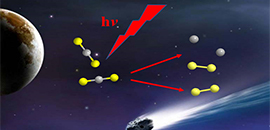 01 28, 2021Dalian Coherent Light Source Reveals Origin of Interstellar Medium S2Researchers observed the C+S2 product channel from CS2 photodissociation for the first time using a home-made Time-Sliced Velocity Map Ion Imaging (TS-VMI) experimental setup, based on the Dalian Coherent Light Source (DCLS).
01 28, 2021Dalian Coherent Light Source Reveals Origin of Interstellar Medium S2Researchers observed the C+S2 product channel from CS2 photodissociation for the first time using a home-made Time-Sliced Velocity Map Ion Imaging (TS-VMI) experimental setup, based on the Dalian Coherent Light Source (DCLS).
Studying the creation and evolution of sulfur-containing compounds in outer space is essential for understanding interstellar chemistry. CS2 is believed to be the most important molecule in comet nuclei, interstellar dust, or ice cores. It could produce CS and S2 fragments after photodissociation.
The International Ultraviolet Explorer satellite only observed the emission spectra of CS and S2, not that of CS2. The photodissociation mechanism of CS2 molecules remains unclear, and S2 fragments have not been experimentally observed before.
Recently, a team led by Prof. YUAN Kaijun from the Dalian Institute of Chemical Physics (DICP) of the Chinese Academy of Sciences (CAS), in cooperation with Prof. WANG Xing'an's group from the University of Science and Technology of China, observed the C+S2 product channel from CS2 photodissociation for the first time using a home-made Time-Sliced Velocity Map Ion Imaging (TS-VMI) experimental setup based on the Dalian Coherent Light Source (DCLS).
Researchers Directly Observed the C + S2 Channel in CS2 Photodissociation (Image by LI Zhenxing)
This study, published in Journal of Physical Chemistry Letters on January 11, provided direct experimental evidence for the origin of the interstellar medium S2 fragments observed previously.
The researchers investigated the two-photon ultraviolet (UV) and one-photon vacuum ultraviolet (VUV) photodissociation dynamics of CS2 molecules via the VUV free-electron laser (FEL) at DCLS.
They directly observed the C+S2 product channel from CS2 photodissociation and obtained images of the electronically ground/excited states of S2 products with vibrational excitation. The electronically-excited states of the central atom of the CS2 molecule played an important role in the isomerization and photodissociation processes.
This research demonstrated that interstellar medium S2 fragments could be directly generated from CS2 photodissociation.
"Given the similarity of OCS studied in our previous works and CS2 in this work, we believe that the central-atom elimination channel is more general than expected in the photodissociation of triatomic molecules," stated Prof YUAN.
This work was supported by the Chemical Dynamics Research Center, the National Natural Science Foundation of China, and the Key Technology Team of CAS. (Text by LI Zhenxing) -
 01 26, 2021Scientists Reveal Dynamic Mechanism of Lead-free Quadruple Perovskite Nanocrystals and Highly Sensitive PhotodetectorsResearchers from DICP reported the luminescence enhancement mechanism of a series of new lead-free quadruple halide perovskite nanocrystals, and prepared high-performance photodetectors.
01 26, 2021Scientists Reveal Dynamic Mechanism of Lead-free Quadruple Perovskite Nanocrystals and Highly Sensitive PhotodetectorsResearchers from DICP reported the luminescence enhancement mechanism of a series of new lead-free quadruple halide perovskite nanocrystals, and prepared high-performance photodetectors.
In recent years, lead-free halide perovskite nanocrystals have been drawn more and more attention due to their low toxicity, high stability and chemical diversity.
It is important to reveal the carrier dynamics of the novel lead-free perovskite nanocrystals and to apply them effectively in the field of optoelectronic devices.
A research group led by Prof. HAN Keli from the Dalian Institute of Chemical Physics of the Chinese Academy of Sciences reported the luminescence enhancement mechanism of a series of new lead-free quadruple halide perovskite nanocrystals, and prepared high-performance photodetectors.
This study was published in Adv. Mater. on January 25.
Efficient luminescent halide quadruple‐perovskite nanocrystals via trap‐engineering for highly sensitive photodetectors (Image by YANG Bin and BAI Tianxin)
The researchers reported for the first time a series of quadruple perovskite colloidal nanocrystals with ordered vacancies. By alloying Cs4MnBi2Cl12 nanocrystals, the fluorescence quantum yield could be increased by nearly 100 times.
Carrier ultrafast dynamics studies found that in the quadruple perovskite nanocrystals, free excitons were rapidly self-trapped as "self-trapped excitons", and a self-trapped exciton-assisted donor-acceptor (Mn2+) occured energy transfer process. Alloying could eliminate the ultra-fast defect state trapping process that competed with energy transfer, and increased the crystallinity of the nanocrystals, thereby improving the luminous efficiency.
Based on the alloyed quadruple perovskite nanocrystals with high crystallinity and long carrier lifetime, the researchers prepared a photodetector, which had ultra-high responsivity. The sensitivity was much higher than the previously reported photodetectors based on lead-free perovskite nanocrystals.
This work shows that the quadruple perovskite type nanocrystal opens up new possibilities for photovoltaic applications.
This work was supported by the National Natural Science Foundation of China. (Text by YANG Bin and BAI Tianxin)